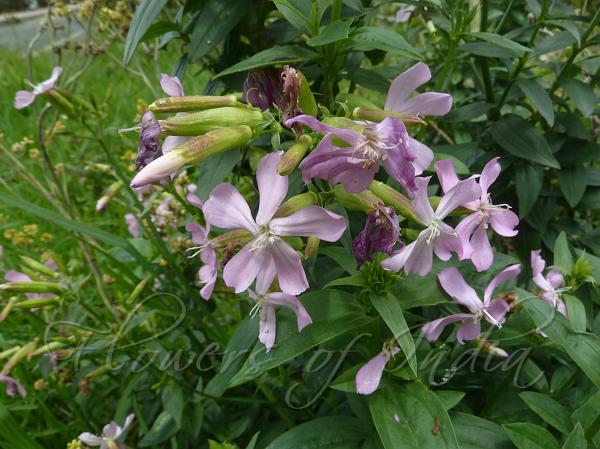|
| Common Soapwort |
|

|

| File size | 403253 |
| Original date | 6/4/16 10:15 AM |
| Resolution | 2560 x 1920 |
| Flash | Flash did not fire, auto |
| Focal length | 4.1mm |
| Exposure time | 1/250s |
| Aperture | 4.0 |
| Focus Distance | |
| Metering Mode | Multi-segment |
| Camera make | Panasonic |
| Camera model | DMC-TZ10 |
| Sensor type | OneChipColorArea |
|
|
|
|
Photo: |
Botanical name: Saponaria officinalis Family: Caryophyllaceae (Carnation family)
Common Soapwort is a perennial herb which derives its generic name
saponaria from its utility as a soap. The plants possesses leafy,
unbranched stems, often tinged with red. It grows in patches, attaining a
height of 70 cm. The broad, lanceshaped, stalkless leaves are opposite and
4-12 cm long. Its sweetly scented pink or white flowers are radially
symmetrical. Each of the five flat petals have two small scales in the
throat of the flower. Flowers are about 2.5 cm wide. They are arranged in
dense, clusters at the end of the main stem and its branches. The long
tubular sepal tube has five pointed red teeth. Soapwort's native range
extends throughout Europe to western Siberia. It is cultivated in Kashmir,
and often found growing wild. A soap can be obtained by boiling the whole
plant (but especially the root) in water. It is a gentle effective
cleaner, used on delicate fabrics that can be harmed by synthetic soaps.
The best soap is obtained by infusing the plant in warm water. Soapwort is
sometimes recommended as a hair shampoo, though it can cause eye
irritations. Flowering: June-October.
Medicinal uses: Soapwort root, has been used as an alternative
medicine since ancient times. It is medicinal as an alterative,
antiscrophulatic, cholagogue, depurative, diaphoretic, mildly diuretic,
expectorant, purgative and tonic. A decoction of the herb is applied
externally to treat itchy skin. One of the saponins in this plant is
proving of interest in the treatment of cancer.
Soapwort root, has been used as an alternative
medicine since ancient times. It is medicinal as an alterative,
antiscrophulatic, cholagogue, depurative, diaphoretic, mildly diuretic,
expectorant, purgative and tonic. A decoction of the herb is applied
externally to treat itchy skin. One of the saponins in this plant is
proving of interest in the treatment of cancer.
Medicinal uses:
 Soapwort root, has been used as an alternative
medicine since ancient times. It is medicinal as an alterative,
antiscrophulatic, cholagogue, depurative, diaphoretic, mildly diuretic,
expectorant, purgative and tonic. A decoction of the herb is applied
externally to treat itchy skin. One of the saponins in this plant is
proving of interest in the treatment of cancer.
Soapwort root, has been used as an alternative
medicine since ancient times. It is medicinal as an alterative,
antiscrophulatic, cholagogue, depurative, diaphoretic, mildly diuretic,
expectorant, purgative and tonic. A decoction of the herb is applied
externally to treat itchy skin. One of the saponins in this plant is
proving of interest in the treatment of cancer. | Identification credit: Gurcharan Singh | Photographed in Pelling, Sikkim & Srinagar, Kashmir. |
• Is this flower misidentified? If yes,